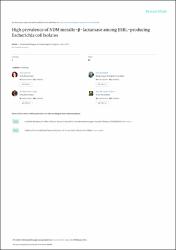| dc.contributor.author | Çetinkol, Yeliz | |
| dc.contributor.author | Sandallı, Cemal | |
| dc.contributor.author | Çalgın, Mustafa Kerem | |
| dc.contributor.author | Yıldırım, Arzu Altunçekiç | |
| dc.contributor.author | Akyıldız, Esma | |
| dc.contributor.author | Karaman, Esin | |
| dc.contributor.author | Çiçek, Ayşegül Çopur | |
| dc.date.accessioned | 2020-12-19T19:48:33Z | |
| dc.date.available | 2020-12-19T19:48:33Z | |
| dc.date.issued | 2017 | |
| dc.identifier.citation | Çetinkol, Y., Sandalli, C., Çalgin, M. K., Yildirim, A. A., Akyildiz, E., Karaman, E., & Çiçek, A. Ç. (2017). High prevalence of NDM metallo-β-lactamase among ESBL-producing Escherichia coli İsolates. Acta microbiologica et immunologica Hungarica, 64(2), 131–141. https://doi.org/10.1556/030.63.2016.027 | en_US |
| dc.identifier.issn | 1217-8950 | |
| dc.identifier.issn | 1588-2640 | |
| dc.identifier.uri | https://doi.org/10.1556/030.63.2016.027 | |
| dc.identifier.uri | https://hdl.handle.net/11436/2109 | |
| dc.description | YILDIRIM, ARZU ALTUNCEKIC/0000-0003-1141-9838; Calgin, Mustafa Kerem/0000-0003-4236-6177 | en_US |
| dc.description | WOS: 000404596900004 | en_US |
| dc.description | PubMed: 28420242 | en_US |
| dc.description.abstract | Resistance to beta-lactams in Enterobacteriaceae has been increasing worldwide. This study aimed to determine the frequency of beta-lactamase genes and antibiotic resistance rates of 140 extended-spectrum beta-lactamase (ESBL)-producing Escherichia coli isolates obtained from urinary tract infection in Ordu Province, Turkey. Isolates were identified by classic methods and by automated system. ESBL production was confirmed by double disk synergy test and antimicrobial susceptibility was investigated by disk diffusion method. All isolates were screened for beta-lactamase coding genes from three groups (A, B, and D) by polymerase chain reaction. the highest rate of susceptible isolates was observed for imipenem (IPM, 99.3%) and ertapenem (ETP, 97.9%), and the highest rate of resistant isolates was observed for cefuroxime (97.9%), ceftriaxone (97.2%), and cefazolin (90.7%). in our study, bl(aCTX-M1-like) group was the most prevalent beta-lactamase (n = 109), followed by bla(TEM) (n = 68), bla(CTX-M2) (n = 22), and bla(SHV) (n = 2). By contrast to low resistance rate to IPM and ETP, we determined bla(NDM) in 31 isolates (22.1%). in co-prevalence of bla(NDM-1) and ESBL-coding genes, a low carbapenem resistance was determined. Wecan confirm that bla(CTX-M1-types) are still the most frequent beta-lactamase coding gene in Turkey. Our study showed the highest prevalence of bla(NDM-1) metallo-beta-lactamase coding gene in ESBL-producing E. coli. | en_US |
| dc.description.sponsorship | Scientific and Technical Research Council of TurkeyTurkiye Bilimsel ve Teknolojik Arastirma Kurumu (TUBITAK) [TUBITAK-113Z054]; Recep Tayyip Erdogan UniversityRecep Tayyip Erdogan University [BAP-2014.102.03.02, BAP-2014.102.03.03] | en_US |
| dc.description.sponsorship | This study was partially supported by a grant from the Scientific and Technical Research Council of Turkey (TUBITAK-113Z054) and Recep Tayyip Erdogan University (BAP-2014.102.03.02 and BAP-2014.102.03.03). | en_US |
| dc.language.iso | eng | en_US |
| dc.publisher | Akademiai Kiado Zrt | en_US |
| dc.rights | info:eu-repo/semantics/openAccess | en_US |
| dc.subject | ESBL-producing E. coli | en_US |
| dc.subject | Beta-lactamase resistance genes | en_US |
| dc.subject | Urinary tract infections | en_US |
| dc.title | High prevalence of NDM metallo-β-lactamase among ESBL-producing Escherichia coli İsolates | en_US |
| dc.type | article | en_US |
| dc.contributor.department | RTEÜ, Fen - Edebiyat Fakültesi, Biyoloji Bölümü | en_US |
| dc.contributor.institutionauthor | Sandallı, Cemal | |
| dc.contributor.institutionauthor | Çiçek, Ayşegül Çopur | |
| dc.identifier.doi | 10.1556/030.63.2016.027 | |
| dc.identifier.volume | 64 | en_US |
| dc.identifier.issue | 2 | en_US |
| dc.identifier.startpage | 131 | en_US |
| dc.identifier.endpage | 141 | en_US |
| dc.ri.edit | oa | en_US |
| dc.relation.journal | Acta Microbiologica Et Immunologica Hungarica | en_US |
| dc.relation.publicationcategory | Makale - Uluslararası Hakemli Dergi - Kurum Öğretim Elemanı | en_US |


















